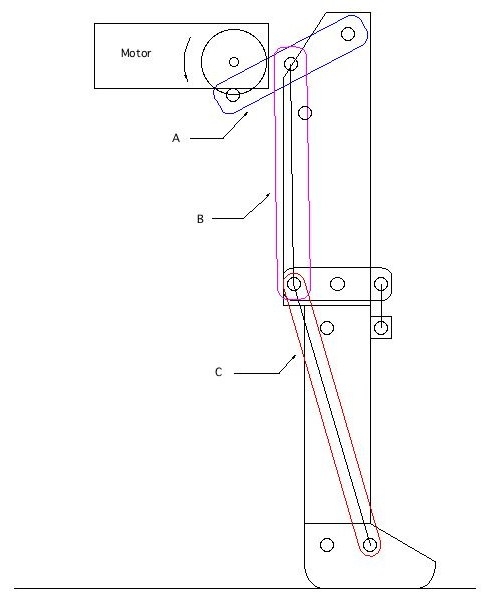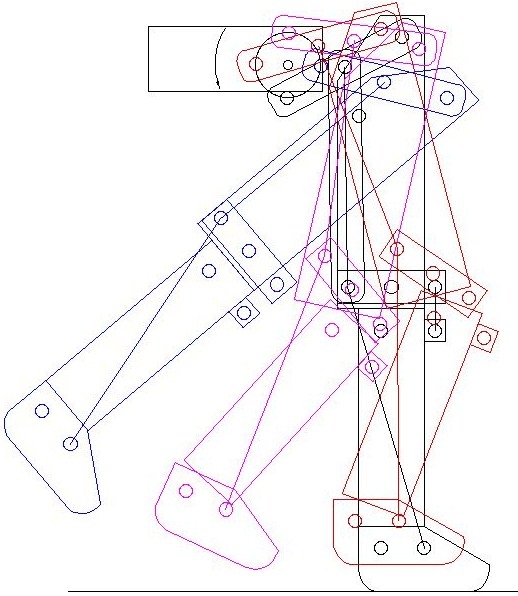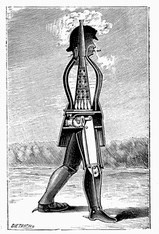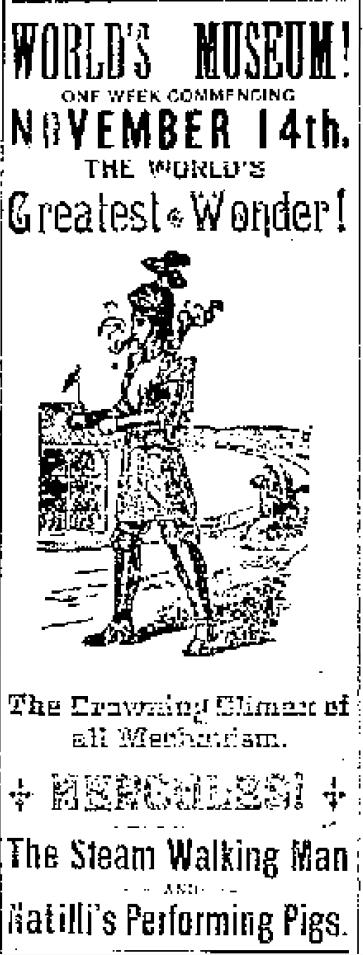
The above model from one of my favourite automata artists, Kandamu.


For those of you expecting a simple, easy post for Prof. George Moore's "Steam Man", well, it isn't going to be one.
The press "announcement" date for the Steam Man is 1893, but Prof. G. Moore had spent two years setting it up [see article below], which gives us a start date of 1891. If I knew the exact issue of the "Scientific American" issue that the article originated, I would be more definite on the dates. The images of the Prof. George Moore "Steam Man" usually show two views, an outside view and a sectional view. According to the text, the article, in fact, is referring to two "Steam Men". A smaller steam man that travels in circles around a post, and a larger steam man then currently being constructed. By way of "Hercules" see below, it appears the larger "Steam Man" did eventuate, and the article mentions that "Hercules" pushed, rather than pulled, an iron cart.
Although Moore is a native a Canada, the "Steam Man" appears to have been built in America, hence my co-joined Canadian/American attribute in the title of this post.
I also believe that Prof. George Moore, native of Canada, is not the same person as George R. Moore, a native of Westford Massachusetts who along with Edward Moore builds the Electric Man pushing a wheelchair. Similar names, similar times, and both walking machines – quite confusing at times.
Another aspect I want to introduce here is the actual "Steam Man" Moore's was based on. Given the reference to the rotary Behren's steam engine, Moore's contrivance is most likely based on this earlier steam man. We know from an earlier post on the Rowe steam man that, in a fit of rage, Rowe "smashed" his machine after an altercation with it. As far as the media and popular press is concerned, there is much more publicity around Dederick's "Steam Man" in that it failed, and was left as a pile of junk in Broadway, New York. So there are many articles out there of the time that confuse which derelict steam man Moore's was actually based upon. Everyone remember's Dederick's, not Rowe's.
Update: 26 July 2010- We now know that Morrison's Steam Man also had a Behren's steam engine, further complicating the origins of Moore's first Steam Man.
The Milford Mail 15 June 1893 p2
An Iron Man.
San Francisco Chronicle: During the last two years Prof. George Moore, a native of Canada, has been at work upon a motive engine, built upon the same plans as the old and discarded "iron man," (see note *) and at last he has succeeded in constructing a model which will not only walk about with a firm, steady gait, but also exerts considerable tractive power. The iron man looks like a medieval knight. In operation the action is quite natural, the hip, knee and ankle movement being successfully imitated. It moves along at a brisk walk and can cover about four or five, miles an hour. The iron man is about 6 feet in height and when in full operation, it is said, cannot be held back by two men.
In the body is the boiler, containing a very large heating surface, and which is supplied with a gasoline fire. Below the boiler is situated the engine.
While small in size, it is a high-speed engine, running up to 3,000 revolutions per minute or more, and hence is of high power , the combination of boiler and engine giving about one-half horse-power. From the engine the exhaust pipe loads to the nose of the figure, whence the steam escapes when the machine is in motion.
Through the head the smoke line is carried and the products of combustion escape from the top of the helmet. The steam gauge is placed by the side of the neck. The skirts of the armor open like doors so as to give free access to the engine. The main body of the figure is made of heavy tin. By reducing gear the engine is made to drive the walking mechanism of the figure at reasonable speed.
In the sectional view is shown the combination of levers by which the figure is made to walk. The engine imparts a swinging motion the whole length of the leg from the hip: a second swinging motion from the knee downward is accomplished by a similar system of levers and connections, and finally a true ankle motion is given to the foot by a rod running down through the lower leg. The heels of tho figure are armed with caulks or spurs, which catch on the surface on which it is walking and give it its power. The steam man is connected to the end of a horizontal bar about waist high, which is fastened to a vertical standard in the center of the track. Thus supported the man walks round in a circle at quite a rapid rate.
(Note: RH – basically an extract from the Scientific American article. It even mentions the sectional view which is not included in the article itself.
* – a reference to Capt. Rowe’s “iron man”) . Also note that the high-speed engine, given that this was based on Rowe's "Steam Man", is a rotary Behren's engine – see description in Capt. Rowe's post on the engine.
Hawarden Independent 22 June,1893 George R. Moore
WALKS BY STEAM POWER.
A Mechanical Man of Giant Size and Ingenious design.
Many years ago, before the applies tion of steam as a motive power had reached the stage of development of the present time, many devices were constructed to make the force subservient to man. One of the most ingenious of these many devices could have been seen within recent times in a down-town junkshop. It was the figure of a man, constructed of iron, and fitted with internal mechanism which, when put in motion by steam, was intended to cause the figure to move much as a human being walks.
During the last two years Prof. George Moore, a native of Canada, has been at work upon a motive engine, built upon the same plans as the old and discarded "iron man," and at last he has succeeded in constructing a model which will not only walk about with a firm, steady gait, but also exerts considerable tractive power. The iron man, as shown in the accompanying illustration, seems in appearance like a medieval knight. In operation the action is quite natural, the hip, knee, and ankle movements being successfully imitated. It moves along at a brisk walk, and can cover about four or five miles an hour. The iron man is about 6 feet in height, and when in full, operation, it is said, cannot be held back by two men.
The mechanism which operates this(illustration 1)

iron figure is not at all as complicated as at first might be supposed, and it is described by the Scientific American, from which the illustrations are taken as follows: "In the body is the boiler, containing a very large beating surface, and which is supplied with a gasoline fire. Below the boiler is situated the engine.
While small in size, it is a high-speed engine, running up to 3,000 revolutions per minute or more, and hence is of High power, the combination of boiler and engine giving about one half-horse power. From the engine the "exhaust pipe leads to the nose of the figure, whence the steam escapes when the machine is in motion. Through the head the smoke flue is carried and the products of combustion escape from the top of the helmet. The steam guage is placed by the side of the neck. The skirts of the armor open like doors, so us to give free access to the engine.The main body of the figures is(illustration 2)

made of heavy tin. By reducing gear, the engine is made to drive the ‘walking' mechanism of the figure at reasonable speed.
"In the sectional view is shown the combination of levers by which the figure is made to walk. The engine imparts a swinging to the whole length of the leg from the hip, a second swinging1 motion, from the knee downward, is accomplished by a similar system of levers and connections, and finally a true ankle motion is given to the foot by tho rod running down through the lower leg. The heels of the figure are armed with calks or spurs, which catch on the surface, on which it is walking and give it its power. As exhibited the steam man is connected to the end of a horizontal bar about waist high, which is fastened to a vertical standard in tho center of the track. Thus supported the man walks round in a-circle at quite a rapid rate of progress,"
For eight years past tho same inventor has been engaged in the construction of a much larger steam man, and it is now said that within the present year the machine will be ready to be placed on exhibition. The new figure in de-signed for use in the streets, and will be powerful enough to draw a wagon containing as many as ten men.
From 1898, the following appeared in Magic: Stage Illusions and Scientific Diversions Including Trick Photography – Introduction by Henry Ridgley Evans, published 1898. Being published by Scientific American [one can see the Scientific American backhand etched script in the etchings], this is essentially the Sci Am article reproduced in a later book.
A STEAM MAN
A good many years ago what was supposed to be a steam man was exhibited all over the country, but finally the "steam man" presumably died, as his remains were quite recently in one of the downtown New York junk stores. The steam man which we illustrate was invented by Prof. George Moore, who exhibited him very widely in the United States.In our illustration (right) we show the section and general view of the steam man. In the body is the boiler, containing a very large heating surface which is supplied with a gasoline fire. Below the boiler is situated the engine. While this steam engine is not at all large, it runs at a very high speed and is of high power, the combination of boiler and engine giving about one-half horse-power. From the engine the exhaust pipe leads to the nose of the figure, whence the steam escapes when the machine is in motion. Through the head the smoke flue is carried, and the products of combustion escape from the top of the helmet. The steam gauge is placed by the side of the neck. The skirts of the armor open like doors, so as to give free access to the engine. The main body of the figure is made of heavy tin. By reducing gear the engine is made to drive the walking mechanism of the figure at reasonable speed.
In our sectional view we show the combination of levers by which the figure is made to walk. The engine imparts a swinging to the whole length of the leg from the hip; a second swinging motion, from the knee downward, is accomplished by a similar system of levers and connections; and finally, a true ankle motion is given to the foot by the rod running down through the lower leg. The heels of the figure are armed with calks, or spurs, which catch on the surface on which it is walking and give it its power. As exhibited, the steam man is connected to the end of a horezontal bar about waist high, which is fastened to a vertical standard in the center of the track. Thus supported, the man walks round in a circle at quite a rapid rate of progress.
For the last eight years the inventor has been at work on a larger man which he hopes to have in operation sometime. The new one is designed for use on the open streets, and is to draw a wagon containing a band. In the upper figure we indicate the method of attachment to the wagon which has been adopted. By the long spring at the side of the figure an elastic connection is secured, so that the figure shall always have its weight supported by the ground. The present man, which is about six feet high, when in full operation, cannot, it is said, be held back by two men pulling against it. The larger man, built for heavier work, is expected to pull as many as ten musicians in his wagon. Our cuts show the general appearance of the figure which is attired in armor like a knight of old, and which appears to be thorourghly operative. The action is quite natural, and the hip, knee, and ankle motion of the human leg have been very faithfully imitated. The figure moves at a brisk walk and can cover about four or five miles an hour.
…"HERCULES"
"Hercules" appears to be the name attributed to the Steam Man for some of the exhibition tours. The etching, borrowed from earlier engravings, suggests the second, larger model was "Hercules". If borrowed from earlier engraving, that engraving would have to have been 1892 – the date of the article.
from The Fort Wayne Gazette 13 Nov 1892 p4

THE FATE OF "HERCULES"
The Daily Herald 04 Oct 1901 p2
WALKING GIANT,
Run by Steam, Goes on a Rampage in a Park.
"Hercules, the Iron Man," is a steam mechanical walking man on exhibition at the Forest City Park summer resort.
He is eight feet high, and when the oil fire inside him is lighted and steam generated he walks about, pushing a sort of iron-wheeled cart. He wears a plug hat and a fiendish grin and puffs exhaust steam through his nostrils.
Late last night some of the campers at the park lighted the fire in "Hercules" after the resort was closed and "Hercules" owner had gone away. The valve had been left open when "Hercules' " fire was put out, and when he got up steam he began to walk about the park. He beat Frank Enstein's monster for a while.
No one knew how to stop him, and he walked all over the park, through the shallow lake, over the tents of the campers and the side-show tents. Sleepers in his path had to be awakened to get them out of the way, for it was impossible to control the steam man's movements. Inequalities in the ground, trees and other obstructions turned him aside, but conuld not stop him. He terrorized the park for an hour, but came to grief at the bar. He marched up to it just as though he had money, bumped against it and knocked it over. "Hercules" fell with the bar and alighted on his head on the other side. He stood there on his head, kicking his feet in the air until his steam went down. Cleveland Special
Chicago Record Herald
One Reply to “1891-1893 – Steam Man – Prof. George Moore – (Canadian/American)”
Comments are closed.